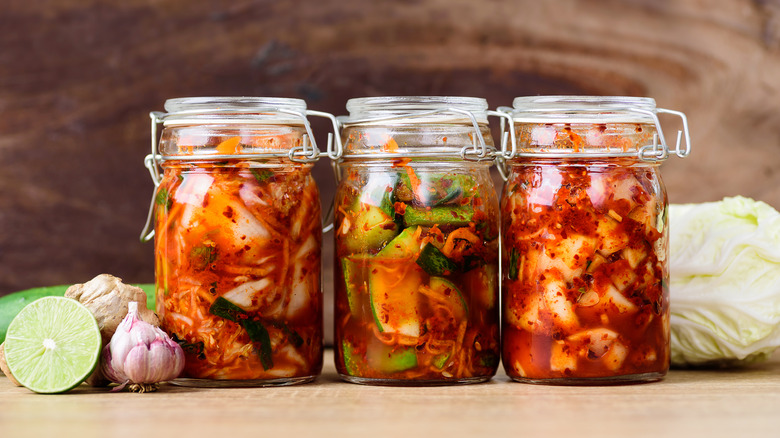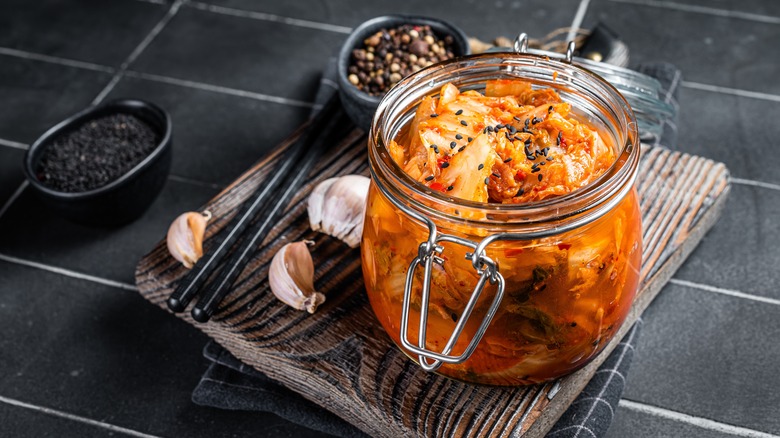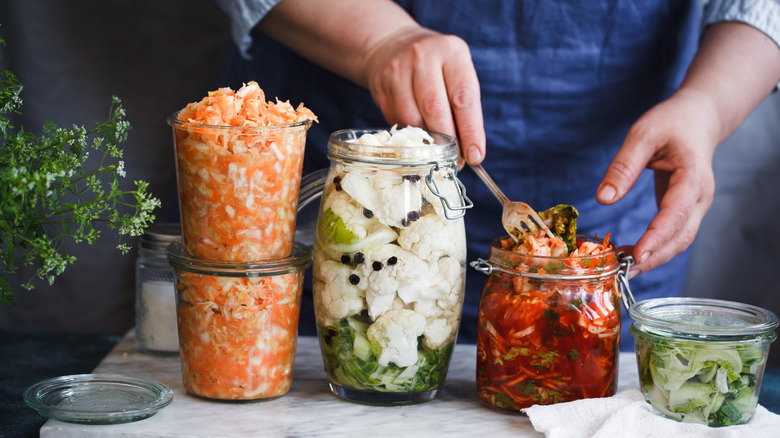Save Your Kimchi Brine For An Unbeatable On-Hand Flavor Bomb
Just like bulgogi and bibimbap, kimchi is another delicious Korean staple that has come to be enjoyed worldwide. With its massive popularity, it's no surprise that kimchi is the national dish of South Korea. For the uninitiated, kimchi is pickled vegetables, often cabbage or radishes, adorned with spicy and flavorful seasonings like red chili peppers and ginger. Its health benefits, versatility, and taste make it a great inclusion to all manner of meals, from coconut braised short rib to Korean-inspired burgers with gochujang aioli.
The pickled vegetables themselves aren't the only part of kimchi that can be used in many ways; kimchi brine also has quite a myriad of uses. Since kimchi juice contains an abundance of seasonings, it brings both a delicious spicy kick in addition to the pungent taste of the brine itself. In fact, kimchi juice has been added to dishes in Korea for ages, particularly in kimchi fried rice, also known as kimchi bokkeumbap. Just like pickle juice, kimchi brine's low pH allows it to substitute the acid component, like vinegar, in many dishes. However, kimchi brine's uses go much further than serving as an ingredient replacement.
What to keep in mind with leftover kimchi brine
Kimchi brine's low pH makes it great for marinades, which require acid to break down muscle proteins to tenderize meat. With kimchi juice's abundance of seasonings, your marinade won't be skimping out on flavor with this swap. Kimchi brine can also substitute vinegar in dressing and combining it with oil helps balance out the acid and distribute flavor. It's also a convenient way to enhance the taste of your dish given that kimchi juice packs a spicy kick with its diverse seasonings like in the aforementioned kimchi fried rice or in other Korean-inspired dishes.
Additionally, it provides umami flavor for dips like hummus and salsa, or even in baking. And while it may sound alarming at first, drinking leftover brine, like pickle juice, has potential health benefits. However, it's best to combine the juice with something to mellow out the acidity, making it an excellent addition to a spicy Bloody Mary. Furthermore, it can be used for other liquid-based dishes such as soups, ramen, and sauces. But keep in mind that making the best use of your kimchi brine requires proper storage.
Store your kimchi brine properly for the best results
Before you can make use of that kimchi juice, you'll have to ensure you're storing it correctly. Leftover brine should be sealed with an airtight lid and kept in the fridge for optimum freshness (though not in the freezer as that will kill off the cultures). The natural acidity of the juice will help kill off bacteria, helping it keep for longer. If stored properly in the fridge, it'll last up to six months, though over time, if the brine contains cultures, after a few weeks the taste will begin to change.
Not only can kimchi brine be used in cooking, but it can also be reused as a brining liquid for other pickles. It no longer serves as a preserving liquid, but you can make refrigerator pickles, also called quick pickles, with it. Since kimchi brine contains an array of seasonings, any quick pickles absorbing the brine's flavor are sure to be enhanced with an added dose of spice. However, kimchi brine should not be continually reused as the acidity level drops and thus the risk of bacteria increases each time. Whether for flavoring or pickling, make sure to keep that leftover brine around for the next time your dish needs a splash of spicy flavor!


